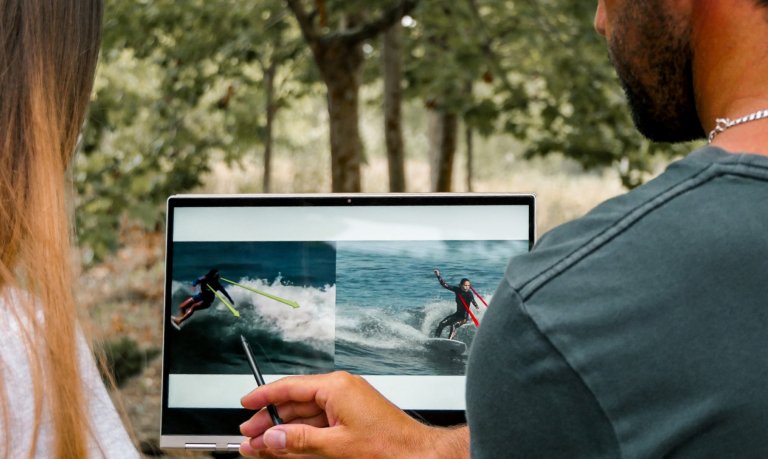Surf skating has quickly become a popular trend among surfers and enthusiasts, praised by some as a helpful tool to improve surfing. However, it has also faced criticism from well-known figures, including the legendary surfer Kelly Slater, who commented on a surf skate coach’s post, saying, “stop this kookiness.” This difference in opinion has led to heated debates within the surfing community.
As a surf coach and practitioner, I believe it’s essential to look at the topic with care and balance. This article aims to present a fair view of surf skating, emphasizing that how well it works mainly depends on how it’s used and practiced.

The Rise and Critique of Surf Skating
Surf skating quickly gained popularity, attracting both praise and criticism. Some professionals, including Kelly Slater, have brushed it off as just a trend or even “kookiness.”
But it’s vital not to follow these opinions without thinking, especially when a significant part of the critics lack the knowledge or experience in surf skating or don’t have expertise in sports science to back their claims. Blindly going along with trends without understanding or questioning them can hold back growth and learning. Neither should we use a critique that Kelly Slater directed at a specific surf skate exercise to generalize the whole surf skate practice.
So, let’s examine the subject with a thoughtful eye.

The Benefits and Drawbacks of Surf Skating
Surf skating’s effectiveness is not all good or all bad; it depends on how it’s used. It offers opportunities to learn and understand some mechanics and movements, train capabilities like speed, endurance, balance, and coordination, and also use it as a tool to work on skills and techniques. But surfing involves more than just a board and techniques – how you read the ocean and waves, your paddle endurance, and your takeoff cannot be learned or improved through surf skating. It can also be harmful if you repeatedly perform incorrect movements and techniques on the surf skate, like wiggling and turning over the front foot. Let’s dive into some examples:
Swimming: Swimming can be a great way to build up endurance and speed – capabilities crucial for surfing. But it can also improve your paddling technique because many movements are similar.
Regular Skateboarding: Regular skateboarding can boost capabilities that you need in surfing, like balance and coordination, and can also improve your skills, like getting the timing and right movements to generate speed on an incline – like a wave.
BodySurfing: Bodysurfing, even without a board, improves important capabilities and skills for surfing and helps you get a better feel for the ocean and wave reading. It’s an invaluable part of understanding surfing and building necessary capabilities.
Surf Skating: Surf skating can enhance balance and coordination on a board and help understand and practice movements and mechanics transferable to surfing. But it must be done correctly; otherwise, it can lead to bad habits or “kookiness.”

Personal Insights and Experience
From my hands-on experience as a coach and surfer, surf skating has been instrumental in enhancing both my students’ abilities and my own. My backside turn used to be awful because I was unable to rotate my upper body correctly. After dedicating time on the surf skate to automate the correct rotation, my surfing improved in that aspect, and now it’s one of my strongest points.
While I was at the skate park with the surf skate, it helped me understand how to generate speed on an incline and improve the timing for the compression/extension on the wave. These things could have been trained with other exercises without a surf skate, but the surf skate made it more fun and more surf-related.
I’m inclined to say that if we have two distinct groups with the same capabilities, and one group just surfs while the other one surfs and also practices surf skate with proper exercises, the group that incorporates surf skating will likely see better results. I can observe this with my clients. Having worked with surf skate for the last seven years, I can see the difference it makes.
The success of surf skating as a training tool is not uniform; it’s influenced by the methods and exercises used. Missteps by some practitioners shouldn’t overshadow the genuine improvements that can be achieved. It’s a matter of understanding the individual’s needs and applying the practice thoughtfully

Surf Skating – Beneficial or Not?
The debate surrounding surf skating is not simple. While some, like Kelly Slater, criticize it as “kookiness,” many, including myself, see its potential benefits. The key lies in how it’s applied and practiced.
Swimming, bodyboarding, regular skateboarding, and surf skating all have their place in surf training. They can enhance various aspects of surfing if used correctly.
What’s most important is not just following trends or opinions but understanding and practicing these exercises in the right way. Let’s recognize surf skating for what it can and can’t do, without letting strong opinions get in the way of clear thinking.
In the end, these benefits depend on doing it the right way. Just because some people may not use surf skating properly doesn’t mean the whole practice is wrong. We need to avoid thinking that one size fits all and work to apply surf skating in the right way.
And I forgot to say its fvck1ng fun.

Written by Afonso Tornelli




